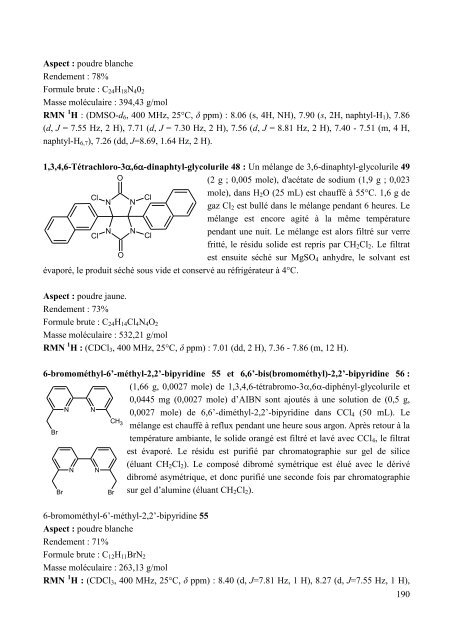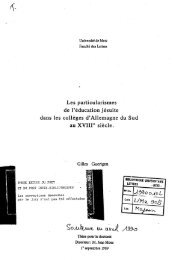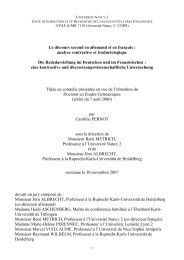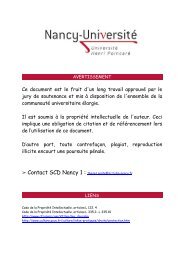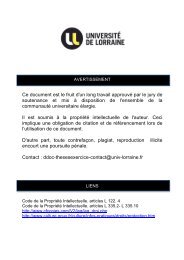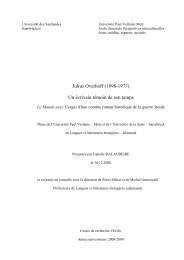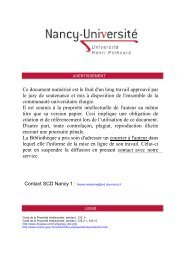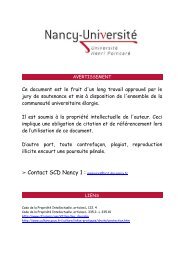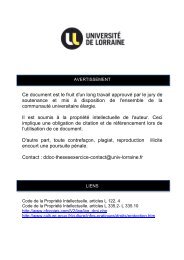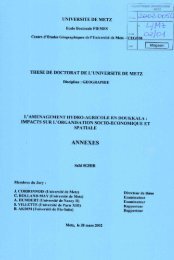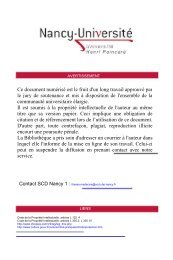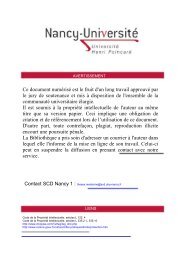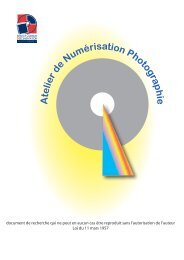Ce document est le fruit d'un long travail approuvé par le jury de ...
Ce document est le fruit d'un long travail approuvé par le jury de ...
Ce document est le fruit d'un long travail approuvé par le jury de ...
Create successful ePaper yourself
Turn your PDF publications into a flip-book with our unique Google optimized e-Paper software.
Aspect : poudre blanche<br />
Ren<strong>de</strong>ment : 78%<br />
Formu<strong>le</strong> brute : C24H18N402<br />
Masse moléculaire : 394,43 g/mol<br />
RMN 1 H : (DMSO-d6, 400 MHz, 25°C, δ ppm) : 8.06 (s, 4H, NH), 7.90 (s, 2H, naphtyl-H1), 7.86<br />
(d, J = 7.55 Hz, 2 H), 7.71 (d, J = 7.30 Hz, 2 H), 7.56 (d, J = 8.81 Hz, 2 H), 7.40 - 7.51 (m, 4 H,<br />
naphtyl-H6,7), 7.26 (dd, J=8.69, 1.64 Hz, 2 H).<br />
1,3,4,6-Tétrachloro-3,6-dinaphtyl-glycoluri<strong>le</strong> 48 : Un mélange <strong>de</strong> 3,6-dinaphtyl-glycoluri<strong>le</strong> 49<br />
O<br />
(2 g ; 0,005 mo<strong>le</strong>), d'acétate <strong>de</strong> sodium (1,9 g ; 0,023<br />
Cl<br />
N N<br />
Cl<br />
mo<strong>le</strong>), dans H2O (25 mL) <strong>est</strong> chauffé à 55°C. 1,6 g <strong>de</strong><br />
gaz Cl2 <strong>est</strong> bullé dans <strong>le</strong> mélange pendant 6 heures. Le<br />
mélange <strong>est</strong> encore agité à la même température<br />
Cl<br />
N N<br />
Cl<br />
pendant une nuit. Le mélange <strong>est</strong> alors filtré sur verre<br />
fritté, <strong>le</strong> résidu soli<strong>de</strong> <strong>est</strong> repris <strong>par</strong> CH2Cl2. Le filtrat<br />
O<br />
<strong>est</strong> ensuite séché sur MgSO4 anhydre, <strong>le</strong> solvant <strong>est</strong><br />
évaporé, <strong>le</strong> produit séché sous vi<strong>de</strong> et conservé au réfrigérateur à 4°C.<br />
Aspect : poudre jaune.<br />
Ren<strong>de</strong>ment : 73%<br />
Formu<strong>le</strong> brute : C24H14Cl4N4O2<br />
Masse moléculaire : 532,21 g/mol<br />
RMN 1 H : (CDCl3, 400 MHz, 25°C, δ ppm) : 7.01 (dd, 2 H), 7.36 - 7.86 (m, 12 H).<br />
6-bromométhyl-6’-méthyl-2,2’-bipyridine 55 et 6,6’-bis(bromométhyl)-2,2’-bipyridine 56 :<br />
(1,66 g, 0,0027 mo<strong>le</strong>) <strong>de</strong> 1,3,4,6-tétrabromo-3,6-diphényl-glycoluri<strong>le</strong> et<br />
0,0445 mg (0,0027 mo<strong>le</strong>) d’AIBN sont ajoutés à une solution <strong>de</strong> (0,5 g,<br />
N N 0,0027 mo<strong>le</strong>) <strong>de</strong> 6,6’-diméthyl-2,2’-bipyridine dans CCl4 (50 mL). Le<br />
Br<br />
CH3 mélange <strong>est</strong> chauffé à reflux pendant une heure sous argon. Après retour à la<br />
température ambiante, <strong>le</strong> soli<strong>de</strong> orangé <strong>est</strong> filtré et lavé avec CCl4, <strong>le</strong> filtrat<br />
<strong>est</strong> évaporé. Le résidu <strong>est</strong> purifié <strong>par</strong> chromatographie sur gel <strong>de</strong> silice<br />
N N<br />
(éluant CH2Cl2). Le composé dibromé symétrique <strong>est</strong> élué avec <strong>le</strong> dérivé<br />
dibromé asymétrique, et donc purifié une secon<strong>de</strong> fois <strong>par</strong> chromatographie<br />
sur gel d’alumine (éluant CH2Cl2).<br />
Br Br<br />
6-bromométhyl-6’-méthyl-2,2’-bipyridine 55<br />
Aspect : poudre blanche<br />
Ren<strong>de</strong>ment : 71%<br />
Formu<strong>le</strong> brute : C12H11BrN2<br />
Masse moléculaire : 263,13 g/mol<br />
RMN 1 H : (CDCl3, 400 MHz, 25°C, δ ppm) : 8.40 (d, J=7.81 Hz, 1 H), 8.27 (d, J=7.55 Hz, 1 H),<br />
190


